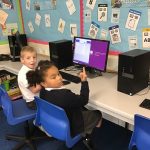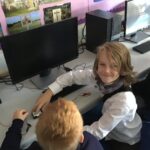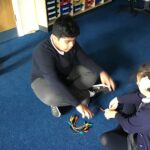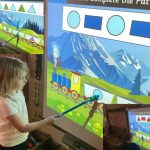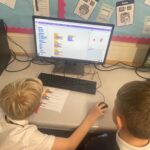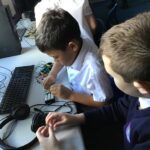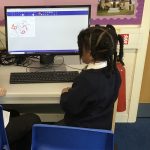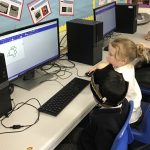At Leamington Community Primary, we want our children to develop a passion for computing. We want them to have no limits to what their ambitions are. We want them to grow up with the desire to be software engineers, video game designers, web developers or IT consultants. We want them to embody our core values. Our computing curriculum has been carefully crafted so that our children develop their digital capital. We want our children to remember their computing lessons in our school, to cherish these memories and embrace the opportunities they are presented with!
At Leamington, we firmly believe that to make the most of the internet, children need to make smart decisions when online. Our school has acquired the 360 Safe Award which has helped empower our children to use the internet safely and wisely and to be confident explorers of the online world.
Curriculum Intent
At Leamington Community Primary School, we believe that Computing lessons play a vital role in children’s education. Use of computers and different devices enables children to solve problems, increases their confidence and helps them to become more aware of the ever-changing world we live in. We believe our curriculum ignites curiosity and inspires our children to look forward into the future. The development of Computing is changing at home and in the community, its impact on the lives of individuals continues to grow and it is essential that our pupils can take advantage of its opportunities and understand its effects. Therefore, it is important that pupils in our school gain the appropriate skills, knowledge and understanding to have the confidence and capability to use computing throughout their lives.
Curriculum Implementation
At Leamington, we are currently developing our computing curriculum to be taught in line with our immersive curriculum. We will be adapting the SIL Planning ‘Teach Computing’. We believe it will not only be creative and inclusive but to also provide opportunities that will be challenging and ignite curiosity through our immersive and interactive learning. We are encouraging staff to embed computing across the whole curriculum to make learning creative and accessible. We want our pupils to be fluent with a range of tools to best express their understanding and hope by Upper Key Stage 2, children will have the independence and confidence to choose the best tool to fulfil the task and challenge set by teachers.
Curriculum Impact
We encourage our children to enjoy and value the curriculum we deliver. We will constantly ask the WHY behind their learning and not just the HOW. We want learners to discuss, reflect and appreciate the impact computing has on their learning, development and well being. Learning in computing will be enjoyed across the school. Teachers will have high expectations and quality evidence will be presented in a variety of forms. Children will use digital and technological vocabulary accurately, alongside a progression in their technical skills. They will be confident using a range of hardware and software and will produce high-quality purposeful products. Children will see the digital world as part of their world, extending beyond school, and understand that they have choices to make. They will be confident and respectful digital citizens going on to lead happy and healthy digital lives.
We use formative assessment information in every computing lesson. Staff use this information to inform their short-term planning. This helps us provide the best possible support for all of our pupils, including the more able and children with SEND. The assessment milestones for each phase have been carefully mapped out and further broken down for each year group. This means that skills in computing will be progressive and built on year on year. (A spiral curriculum).
Assessment
Our staff use a range of assessment techniques to ensure that children are reaching their full potential and being given the appropriate support.
- Evidence – Use e-Portfolio SeeSaw as well as maintaining individual folders on the school network for each pupil to contain digital work. Further to this, floor books are used to keep worksheets and links (QR codes) to work.
- Teacher Feedback – Face-to-face feedback given to children
- Self/Peer – children look at their partner’s work and make comments about it.
- Diagnostic Testing – Creative online interactive quizzes (e.g. Kahoot) provide engaging opportunities to assess pupil understanding and bring a gamification aspect to assessment
- Assessment Projects – Using end-of-unit open-ended project tasks allow pupils to demonstrate learning
- Summative Assessment – Chidlren to answer the pre/post assessment quizzes from the Teach Computing Curriculum for relevant topics.
All of this information is gathered and reviewed. It is used to inform further curriculum developments and provision is adapted accordingly.
Computing in Foundation Stage
Although the ‘Technology’ strand has now been removed from ‘Understanding the World’ section in Development Matters we know how important technology is and will be for the lives of the children we teach.
What does Computing look like in our EYFS?
We learn through play across the curriculum and try to provide children with as many opportunities to develop their ICT skills building on listening skills, curiosity and creativity and problem solving.
Technology in our Early Years can mean:
- Playing with toys with buttons, flaps and simple mechanisms and learning how to operate them
- taking a photograph with a camera or tablet
- searching for information on the internet and watching the adults around me model this
- playing games on the interactive whiteboard
- exploring an old typewriter or other mechanical toys
- using a Beebot or other programmable toys
- watching a video clip
- listening to music
- listening to or reading stories on different devices (e-books)
- using age appropriate computer software
- children being exposed to emails, texts and how technology can be used as a form of communication. We do this through our narrative curriculum using technology for a purpose.
- A half termly wellbeing session dedicated to e-safety with e-safety being high priority and discussed in an age appropriate way when children are using the internet.
We allow our children the opportunity to explore technology trough planned and child-led activities. We have taken aspects from the Technology strand of Birth to Five to ensure that our children develop a familiarity with equipment and vocabulary and confidently access the Year 1 computing curriculum.
Computing and SEND
At Leamington, we passionately believe that Computing has the potential to empower pupils with SEND and transform their lives. With the right blend of progressive, imaginative planning, exposure to a broad range of tools and technologies and comprehensive support it is possible that all children can fulfil their potential – in Computing and throughout the curriculum.
Computing and Information Technology are essential tools for inclusion. They enable children with SEND, whatever their needs, to use technology purposefully in ways that make the wider curriculum accessible, empower those with communication difficulties to engage with others and to fully include everyone in activities and learning.
We offer children with SEND varied and engaging ways to communicate, collaborate, express ideas and demonstrate success. From making and editing video/audio footage, programming animations, games and apps to creating rich web content – all pupils have an opportunity to participate, be challenged, learn and progress.
Supporting children’s mental health
Children’s use of technology is increasing annually with social media now a part of many families’ lives. Screen time can cover a broad range of activities from reading novels on an e-reader or doing research for a school project to cooperatively playing games with others across the world. Even on the same platform, children and young people could have vastly different experiences depending on the content they are accessing. Therefore, when considering the risks and benefits of technology use, an understanding of the content with which children and young people are engaging is essential.
For children and young people there are many positives about these innovations: instant communication with family and friends around the world; the ability to play and be creative; access to high-quality information; the ability to socialise in a different environment; and online support for a range of health concerns and identity themes.
However, these devices can pose potential challenges to the health and well-being of children and young people. Staff and parents work together to ensure children are safeguarded, have an appropriate amount of screen time, the programs they use are in line with parents’ parental controls and that above all, there is a balance between screen time and other activities. Further to this, as a whole school we have completed the 360 Safe Mark; we ensure the e-safety is embedded across the curriculum and via assemblies etc.
If however, there is an online incident that occurs and it affects children’s mental health; the incident is logged as an online incident and monitored. If this impacts the child’s mental health – it can be referred to the Inclusion Team or to our mental health subject leader for personalised support.
Subject Leader: Ashley Fergusson
Take a look at our Esafety page
Documentation:
- Computing Progression of skills
- ComputIng curriculum Map
- Computing and E-Safety Policy
- Primary National Curriculum – Computing
- Computing Vocabulary Progression
Knowledge, Understanding and Skills


